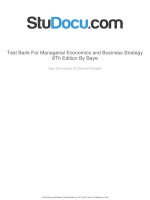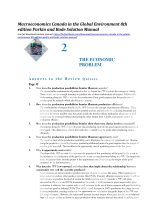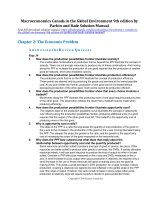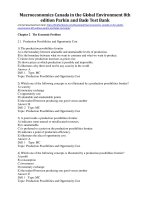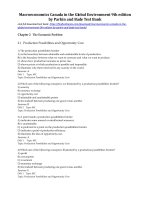Law and ethics in the business environment 8th edition by halbert and ingulli test bank
Bạn đang xem bản rút gọn của tài liệu. Xem và tải ngay bản đầy đủ của tài liệu tại đây (141.12 KB, 6 trang )
Law and Ethics in the Business Environment 8th edition by
Halbert and Ingulli Test Bank
Link full download solution manual: />Link full download test bank: />
Chapter 2
The Duty of Loyalty: Whistleblowing
Questions
1. Select the best definition of whistleblower:
a. the sole goal of modern ethics training
b. originated from the Latin "qui tam pro domino rege quam pro sic ipso in hoc parte
sequitur" meaning "who as well for the king as for himself sues in this matter."
c. a narrow exception under the general rule of at-will employment
d. people who report unethical or illegal activities under the control of their employers
ANSWER: D
PAGE: 49
2. Under the legal doctrine of “employment at will” an employee can be lawfully terminated
from her job for:
I.
II.
wearing a shirt that clashes with her suit
any non-discriminatory reason
III.
complaining about illegal activity in the workplace
IV.
only for good cause
a. a. I only
b. b. II only
c. c. I and II
d. d. III and IV
ANSWER: C
PAGE: 49
3. Exceptions to the rule of employment-at-will include which of the following?
I.
organization of unions
II.
passage of Sarbanes Oxley Act
III.
raising of public policy issues
IV.
promise of implied-contract or covenant-of-good-faith
a. I only
b. II only
c. I and II
d. I, II, III, IV
ANSWER: D
PAGE: 52-53
4. The Food Safety Modernization Act:
I.
II.
offers some protections for whistleblowers
covers vegetables, seafood and dairy
III.
covers eggs and poultry
IV.
gives the FDA power to make mandatory recalls
a. I and II only
b. I, III and IV only
c. I, II and IV only
d. I, II, III, IV
ANSWER: C
PAGE: 68 - 69
5. Ag Gag would criminalize:
a. undercover video recordings showing animal cruelty
b. recordings of public health violations occurring in agricultural facilities
c. Both a. and b.
d. Neither a. nor b.
ANSWER: C
PAGE: 69
6. The National Labor Relations Board has stated that the right to discuss working conditions
freely and without fear of retaliation should exist at the work site. However, the Board
believes the same right does not exist online.
a. True
b. False
ANSWER: B
PAGE: 71
7. The Constitution does not always protect free-speech rights for what public employees say
on the job. Which of the following is true?
a. When a citizen enters government service, the citizen need not accept certain limitations
on his or her freedom.
b. Public employees may speak out on matters of public concern and have First Amendment
protection but not when they speak out in the course of their official duties.
c. As public employees speak out and receive First Amendment protection, there is an
acceptable chilling of the speech of all potential whistleblowers.
d. None of the above
ANSWER: B
PAGE: 73
8. To determine whether a public employee receives First Amendment protection from speech
(and therefore cannot be fired for it), the Supreme Court has stated that all of the following
are important except:
a. The employer must have a justification for treating the employee differently than it
would treat a member of the general public.
b. The speech cannot be about political topics.
c. The speech must be about something of great public concern.
d. The speech cannot be made as part of the employment (such as an internal
memorandum).
ANSWER: B
PAGE: 74 - 75
9. When Qui Tam whistleblowers against the pharmaceutical industry were questioned about
their motivation, several reasons were mentioned. Which of the following was NOT given as
a reason?
a. Potential risk to public health.
b. Unfair employment practices.
c. Financial reward.
d. Self-preservation.
ANSWER:
C
PAGE: 80
Essay Questions
10. According to research, what are the characteristics of the typical whistleblower?
ANSWER: The typical whistleblower is a long-term, highly loyal employee who strongly
believes his or her company should do the right thing. A whistleblower tends to try to resolve the
issue(s) internally. If nothing is done in response to the complaint(s), the whistleblower feels
compelled to disclose the problem to authorities outside the company and/or the media.
PAGE 46
11. According to the Montana Wrongful Discharge from Employment Act, what are the three
elements of a wrongful discharge?
ANSWER: (1) It was in retaliation for the employee’s refusal to violate public policy or for
reporting such violation. (2) The employee had completed the employment probationary period
and the discharge was not for good cause. (3) The employer violated the express provisions of
its own written personal policy.
PAGE 64
12. How was Ken Kendrick of The Peanut Corporation of America a typical whistleblower? An
atypical whistleblower?
ANSWER: Mr. Kendrick’s was a typical whistleblower because he tried to resolve the issue
internally with his manager and the CEO. He was an atypical whistleblower because he next
tried to deal with the problems anonymously and then left the company without doing anything
more until a salmonella outbreak at a different PCA plant. Second, although he realizes that he
did the right thing, he sees himself as more of a “prison snitch” than a whistleblower.
PAGE 65 -68
13. Explain what happened in the 1968 Supreme Court’s re-interpretation of the First
Amendment to the U.S. Constitution regarding public employees’ limited speech protections.
ANSWER: In 1968, the case of Pickering v. Board of Education addressed a public school
teacher’s criticism of the local school board. The Court weighed “the interests of the teacher, as a
citizen, in commenting upon matters of public concern” against the State (a.k.a. the school
board). The Pickering case gave public employees limited speech protection.
PAGE 73
14. Describe at least two other times since the Pickering decision in which the Supreme Court
revisited the ruling. What were the outcomes?
ANSWER: In 1983, in Connick v. Myers, Ms. Myers had distributed a questionnaire at her place
of employment. The circular not only addressed internal matters, but also matters of legitimate
public concern, including pressure put on employees to work on political campaigns. The
Connick court determined that the questionnaire had just enough public interest to be examined
under the Pickering test, although a statement limited to internal matters would not be. Myers
lost the case since the court demonstrated that her questionnaire interfered with working
relationships in the workplace.
In 2006, Richard Ceballos, a deputy district attorney, supervised other lawyers in the DA’s
office. A defense attorney contacted Ceballos to tell him he would be challenging a search
warrant because the warrant was based on “inaccuracies” in the supporting affidavit. Ceballos
agreed to investigate. When he arrived at the scene in question, a “long driveway” was a separate
road. Ceballos told his supervisors the case should be dismissed because of the obvious
misrepresentations in the affidavit. Ceballos was reprimanded for this behavior, which lead to
retaliations, reassignments, transfers, and denied promotion. He sued, claiming those actions
violated his First Amendment rights. The Supreme Court Justices were divided in their opinions.
PAGE 73 – 77
15. As discussed in the text, False Claims Act or qui tam suits have been successful in the health
care industry. The text mentions several things that all these successful claims have in
common. Discuss those things.
ANSWER: (1) All qui tam plaintiffs tried to fix the problems internally before they went to
the outside; (2) all were told that the behavior they were concerned about was either legal or
were told to drop the complaint; (3) very few intended from the start to use the qui tam
process; (4) none blew the whistle out of any concern for money, but instead were concerned
with public health and safety; and (5) most of them found the process incredibly grueling.
PAGE 74
